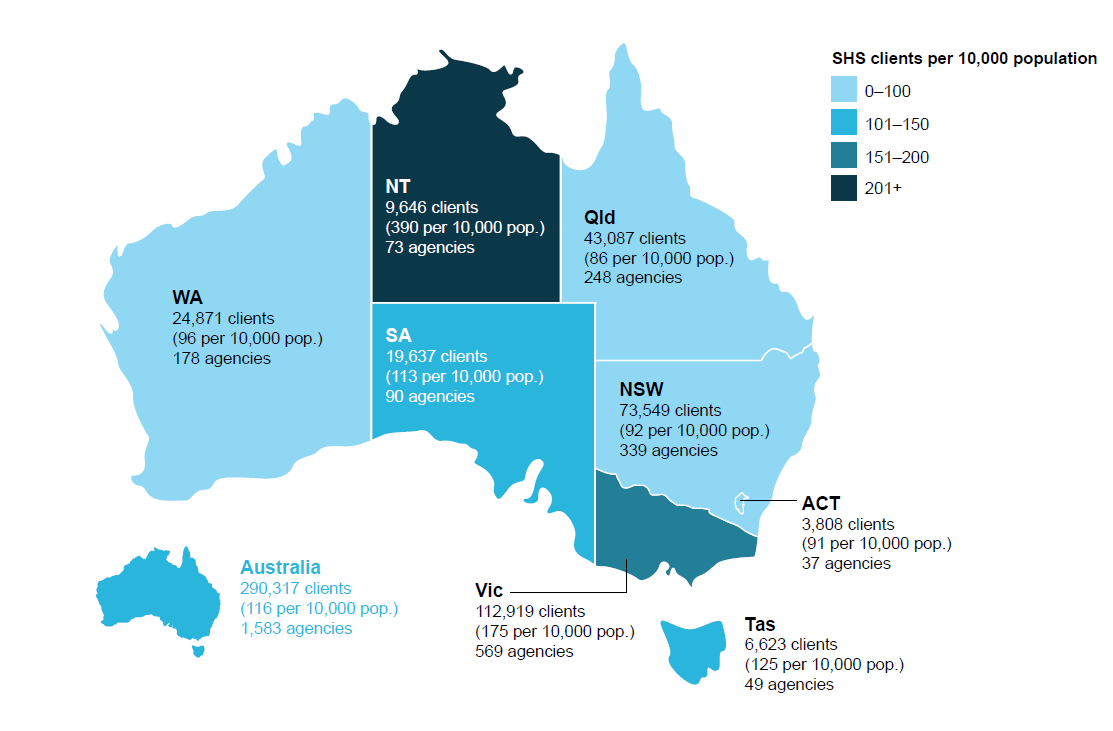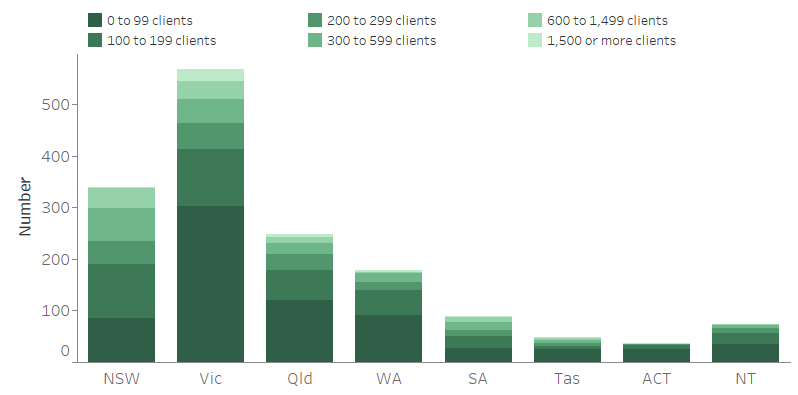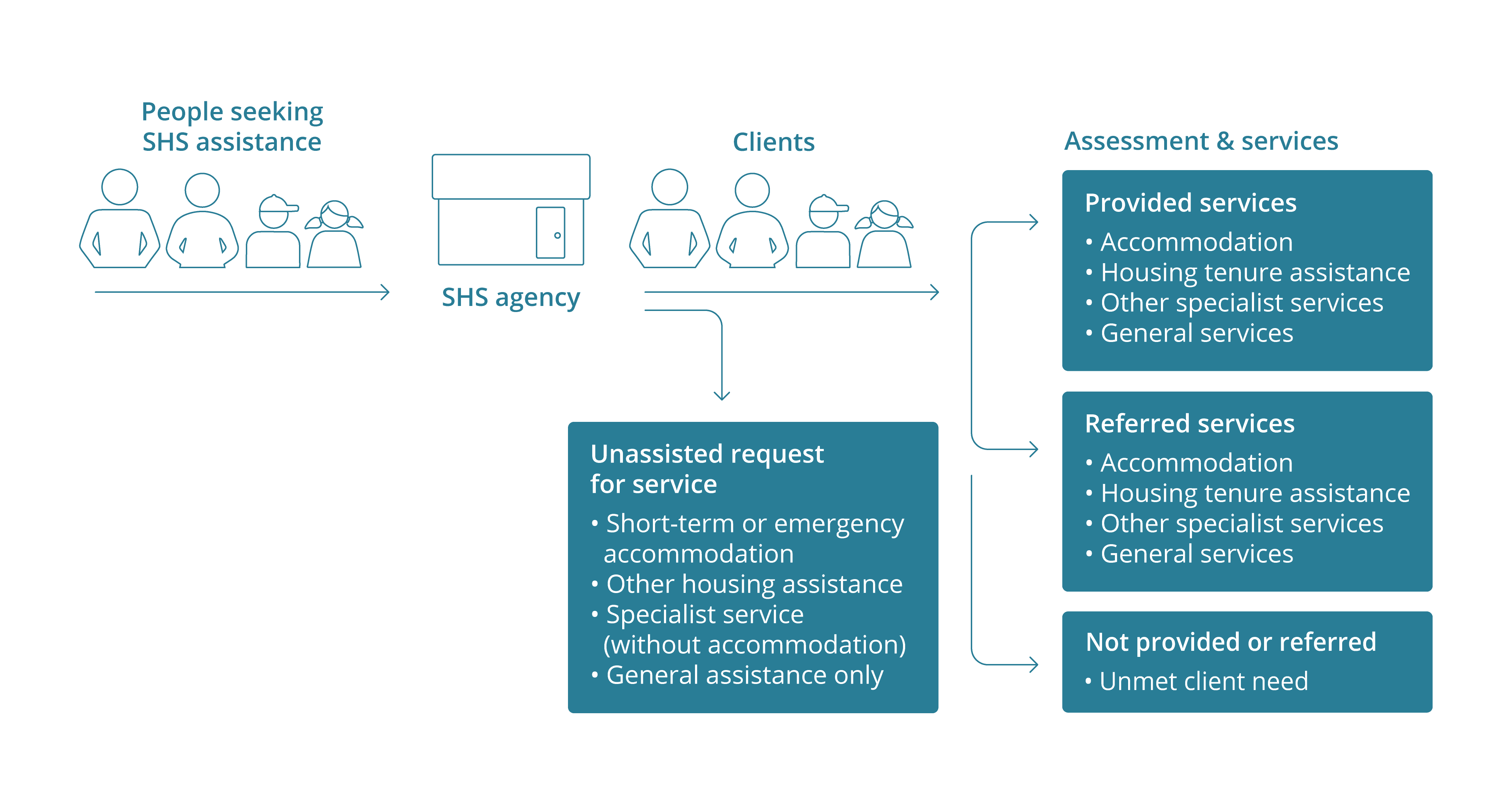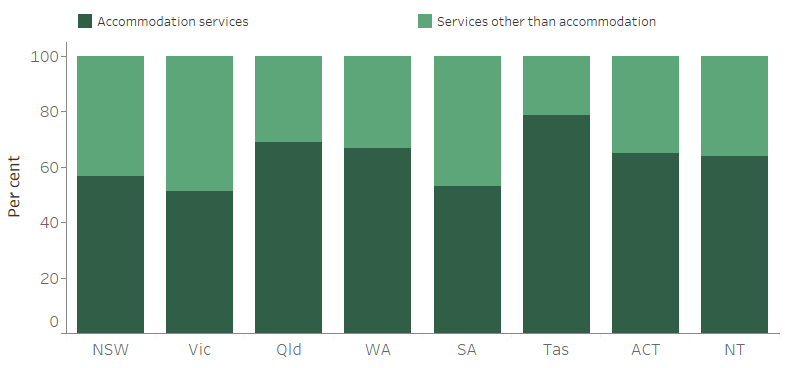Policy framework for reducing homelessness and service response
Governments across Australia fund a range of services to provide support to people who are experiencing homelessness or who are at risk of homelessness. These services are delivered by non-government organisations including agencies specialising in delivering services to specific target groups (such as young people or people experiencing family and domestic violence), as well as those that provide more generic services to those facing housing instability.
This report describes:
- Information about people who have received assistance from specialist homelessness agencies in 2018–19, the type of assistance they received, and changes in their housing whilst receiving support.
- Client characteristics, the services they received, and their outcomes, including changes over time.
- Data on people who requested services in 2018–19, but were not provided with support at that time.
The data in this publication are produced from the Specialist Homelessness Services Collection (SHSC), conducted by the Australian Institute of Health and Welfare (AIHW). Data are provided to the AIHW by almost 1,600 homelessness agencies allowing this report to be compiled and published. The AIHW thanks the agencies and their clients for making this report possible.
People who are experiencing homelessness or who are at risk of homelessness may also access a range of mainstream services that are available to the broader community (such as income support payments or health services). These services are not described in this report.
In 2017–18, an Australian Defence Force (ADF) indicator was introduced into the SHSC to provide a better understanding of the extent to which veterans need and seek support from Specialist Homelessness Services (SHS) agencies. Results from the first 2 years of implementation are presented. Data for clients living with disability are presented from 2013–14 onwards.
The policy framework for reducing homelessness
Many Australians experience events in their lifetime that may place them at risk of, or result in, homelessness. Access to affordable housing is a key issue for all Australians, particularly those on low-incomes. A lack of affordable housing puts households at an increased risk of experiencing housing stress and can affect their health, education, employment and place them at risk of homelessness. It is estimated that around 1 million low-income households experience housing affordability issues due to rental stress—defined as paying more than 30% of their gross weekly income on housing costs (AIHW 2019, ABS 2019, SCGSP 2019).
On Census night in 2016, 116,427 Australians were homeless, up from 102,439 people in 2011. This equates to a 4.6% increase in the population adjusted rate of homeless persons over 5 years, from 47.6 per 10,000 population in 2011 to 49.8 in 2016. Census homeless estimates include people in supported accommodation for the homeless, people in short-term or emergency accommodation, those ‘sleeping rough’ and people living in severely crowded dwellings—defined as those that require 4 or more extra bedrooms to accommodate the residents. The Australian Bureau of Statistics (ABS) acknowledges that the homeless circumstance may mean that some people are not captured at all in datasets, nor will all those experiencing homelessness be captured in datasets of those accessing particular homelessness services. In addition, certain groups of people (including Indigenous populations, rough sleepers and those in supported accommodation) are more likely to be undercounted on Census night. Hence, homelessness data collected in the Census is an estimation, and susceptible to under/overestimation and under enumeration (ABS 2018).
The National Housing and Homelessness Agreement (NHHA)
In the 2017–18 Budget, the Federal Government announced the establishment of a new National Housing and Homelessness Agreement (NHHA), which came into effect on 1 July 2018. This agreement reformed previous funding agreements with states and territories (the National Affordable Housing Agreement (NAHA) supported by the National Partnership Agreement on Homelessness (NPAH)). The NHHA provides more than $1.5 billion in Commonwealth funding to the states and territories a year, including dedicated funding of $121 million for homelessness services in 2018–19, which states were required to match. Funding for homelessness services will be ongoing and indexed for the first time to provide certainty to front line services assisting Australians who are experiencing homelessness or who are at risk of homelessness (CFFR 2018). All SHS must contribute to the SHSC under this agreement.
The objective of the NHHA
The objective of the NHHA is to contribute to improving access to affordable, safe and sustainable housing across the housing spectrum from crisis housing to home ownership, including to prevent and address homelessness, and to support social and economic participation.
The key outcomes this agreement will contribute to include:
- a well-functioning social housing system that operates efficiently, sustainably and is effective in assisting low-income households and priority homeless cohorts to manage their needs
- affordable housing options for people on low-to-moderate incomes
- an effective homelessness system, which responds to and supports people who are homeless or at risk of homelessness to achieve and maintain housing, and addresses the incidence and prevalence of homelessness
- improved housing outcomes for Indigenous Australians
- a well-functioning housing market that responds to local conditions
- improved transparency and accountability in respect of housing and homelessness strategies, spending and outcomes.
Several national priority cohorts have been specifically identified in the agreement and are expected to be addressed in each state and territory’s homelessness strategy:
- women and children affected by family and domestic violence
- children and young people
- Indigenous Australians
- people experiencing repeat homelessness
- people exiting institutions and care into homelessness
- older people.
In addition, several homelessness priority policy reform areas have been identified:
- achieving better outcomes for people
- early intervention and prevention
- commitment to service program and design.
The Specialist Homelessness Services Collection
A total of 1.2 million clients have been supported by Specialist Homelessness Services since the collection began on 1 July 2011.
The SHSC collects data from homelessness agencies funded under the NHHA (and the previous NAHA and NPAH). State and territory departments identify agencies that are expected to participate in the data collection. These agencies vary widely in terms of the services they provide and the service delivery frameworks they use. The operational frameworks may be determined by the state or territory funding department or developed as a response to local homelessness issues (see What are specialist homelessness agencies? for more details).
All SHSC agencies report standardised data about the clients they support each month to the AIHW, as specified by the SHS National Minimum Dataset (NMDS). Data are collected about the characteristics and circumstances of clients when they first present at an agency. Further data on assistance received and client circumstances are collected at the end of every month in which the client receives services and again when contact with the client has ceased.
Data supplied in accordance with the SHS NMDS, known as the SHSC, builds a comprehensive picture of clients, the specialist homelessness services that were provided to them and the outcomes achieved for those clients (Figure FRAMEWORK.1). The SHSC data provide a measure of the service response directed to those who are experiencing housing difficulty. The data do not provide a measure of the extent of homelessness in the community, although SHSC data on emergency accommodation and supported accommodation do contribute to the profile on homelessness in Australia.
Figure FRAMEWORK.1: Conceptual framework of the Specialist Homelessness Services Collection
The data collected by agencies are based on periods of support provided to clients. Support periods vary in terms of their duration, the number of contacts between SHS workers and clients during the period, and the reasons that support ends. Some support periods are relatively short—and are likely to have begun and ended in 2018–19—while others are much longer, many of which might have been ongoing from the previous year and/or were still ongoing at the end of 2018–19.
Certain information collected about the client (selected letters of name, date of birth and sex) is used to construct a statistical linkage key (SLK). This SLK brings together all data about each client who had multiple support periods (either within the same agency or across different agencies) during the reporting year.
Data tables from which these analyses are drawn are provided as supplementary tables to this report. All percentages given are based on valid responses reported for clients, and the extent of missing data is indicated in the supplementary tables.
Further information about the collection and information about the quality of the data obtained through the SHSC for 2018–19 is available in Technical information.
Delivery of homelessness services across Australia
Each state and territory manages their own system for the assessment, intake, referral and ongoing case management of SHS clients. The key delivery systems operating in Australia are summarised in Box FRAMEWORK.1. Although presented as three distinct models, these systems are representative of a range of approaches that jurisdictions may take to coordinate entry to becoming a client of SHS. Changes implemented by state and territories in the delivery of services and their associated responses have the potential to impact SHSC annual data.
Box FRAMEWORK.1
Community sector funding and support
- Assessment and intake: managed by individual SHS providers, consistent with state or territory policies.
- Referral: refer to other SHS providers if clients’ needs can’t be met by initial SHS provider.
- Can be supported by a coordinating service.
Central information management
- Assessment, intake and referral: managed at any SHS provider, via state or territory central information management tool.
- Central information management system assists in the identification of appropriate services and indicates the availability/vacancy of services at all SHS providers.
Central intake
- Assessment, intake and referral: managed by one or more ‘central intake’ agency.
- Central intake agencies prioritise access to services and only refer clients as services and/or vacancies are available.
- Central information management tool may exist to share information between SHS providers.
What are specialist homelessness agencies?
A specialist homelessness agency in scope for the SHSC is an organisation that receives government funding to deliver accommodation related and/or personal services to people who are homeless or at risk of homelessness. While it is recognised that other organisations not directly funded by governments also provide a wide range of services to this sector, these organisations are not required to provide data to the SHSC.
SHS agencies vary in size and in the types of assistance they provide. Across Australia, agencies provide services aimed at prevention and early intervention, as well as crisis and post crisis assistance to support people experiencing or at risk of homelessness. For example, some agencies focus specifically on assisting people experiencing homelessness, while others deliver a broader range of services, including youth services, family and domestic violence services and housing support services to those at risk of becoming homeless. The service types an agency delivers range from basic, short-term interventions such as advice and information, meals and shower or laundry facilities through to more specialised, time intensive services such as financial advice and counselling and professional legal services (see Glossary for a complete list of service types).
Nationally 1,583 agencies delivered specialist homelessness services to more than 290,300 clients during 2018–19 (Figure FRAMEWORK.2).
Figure FRAMEWORK.2: Specialist homelessness agencies and clients by jurisdiction, 2018–19

Notes
- Clients may access services in more than one state or territory, therefore the Australia total will be less than the sum of jurisdictions.
- The agency count includes only those agencies that provided support periods with valid SLKs.
Source: Specialist Homelessness Services Collection 2018–19.
SHS agencies vary considerably in size, with some agencies assisting less than 100 clients per year and others assisting upwards of 1,500. Some agencies are represented by a larger ‘parent’ organisation while others are individual stand-alone agencies. The number of clients agencies assist (agency size) not only reflects the type and complexity of services provided, but also differing state and territory service delivery models. Agency size is also influenced by jurisdictional specific factors such as the size and geographical distribution of their population. Figure FRAMEWORK.3 illustrates the wide range in agency sizes in each state and territory. In 2018–19, most agencies assisted fewer than 100 clients, except for New South Wales. In New South Wales, a higher number of agencies assisted 100–199 clients than assisted fewer than 100 clients (104 compared with 86), while in South Australia 23 agencies assisted 100–199 clients. Agencies assisting a large number of clients (more than 1,500 in 2018–19) exist in all jurisdictions except the Northern Territory. Victoria had the most agencies of this size (23 agencies).
Figure FRAMEWORK.3: Specialist homelessness agencies, by number of clients assisted and state and territory, 2019–18

Source: Specialist Homelessness Services Collection 2018–19, Supplementary table FRAME.2.
How do people find SHS: a focus on the Ask Izzy website
There are several avenues through which people can find nearby homelessness services. One such mechanism is Ask Izzy, a ‘mobile-first’ designed website connecting people in need to housing, meals, support and counselling services in their local area. The website was launched early in 2016 and has received more than 1.5 million searches in the last financial year (Infoxchange 2019).
Some of the key trends in relation to category searches from the 2018–19 financial year include:
- Food, accounting for 32% of searches.
- Money help, 20%.
- Housing, 18%.
- Everyday things, 10%.
- Centrelink, 5%
The top demographics of those seeking housing support include:
- Mental or emotional difficulties, 24%.
- Families with children, 22%.
- Escaping family violence, 18%.
- Aboriginal or Torres Strait Islander people, 10%.
- Have pets, 8%.
SHS agencies and their service delivery
Once a person has made contact, specialist homelessness services can either be provided to the client by the agency, or a client may be referred to another agency for a specific service (Figure FRAMEWORK.4). In some instances, a client may not receive nor be referred for a service and their need remains unmet.
These unmet needs are captured to assist in determining the ability of the sector to respond to client needs.
An ‘unassisted request for service’ is an instance where a person(s) who approaches an agency is unable to be provided with any assistance (see Technical information). Limited data are collected about these occasions.
Figure FRAMEWORK.4: Access to and delivery of Specialist Homelessness Services

Services provided by specialist homelessness agencies in all states and territories can be categorised as either ‘accommodation services’ (either the direct provision or referral of accommodation or assistance for the client to remain housed) or ‘services other than accommodation’ (Figure FRAMEWORK.5). The proportion of SHS clients receiving accommodation services varied across states and territories in 2018–19, with almost 8 in 10 clients in Tasmania (79%) and more than 6 in 10 clients in Queensland (69%), Western Australia (67%), the Australian Capital Territory (65%) and the Northern Territory (64%) receiving these services. In contrast, 49% of clients in Victoria, 47% of clients in South Australia and 43% of clients in New South Wales were provided services other than accommodation. This variation reflects differences in the demand for accommodation services, service delivery models and housing options across jurisdictions.
Figure FRAMEWORK.5: Clients of Specialist Homelessness Services by service type, state and territory, 2018–19

Notes
- Clients provided or referred accommodation services (short-term or emergency accommodation, medium-term/ transitional housing, long-term housing, assistance to sustain tenancy or prevent tenancy failure or eviction and assistance to prevent foreclosures or for mortgage arrears) are included in the accommodation services category. These clients may have also been provided additional services other than accommodation.
- The denominator for the proportions is the number of clients who were provided or referred any service during 2018–19.
- Clients may access services in more than one state or territory. If they received accommodaton services in any jurisdiction they will be counted as having received these services in all jurisdictions in which they received services.
Source: Specialist Homelessness Services Collection 2018–19, Supplementary table FRAME.3.
References
ABS (Australian Bureau of Statistics) 2019. Housing and occupancy costs, 2017–18. ABS cat no. 4130.0. Canberra: ABS.
ABS 2018. Census of population and housing: estimating homelessness, 2016. ABS cat no. 2049.0. Canberra: ABS.
AIHW (Australian Institute of Health and Welfare) 2019. Housing Affordability. Viewed 18 September 2019.
CFFR (Council on Federal Financial Relations) National Housing and Homelessness Agreement. Viewed 23 January 2019.
Infoxchange 2019 (unpublished data).
SCRGSP (Steering Committee for the Review of Government Service Provision) 2019. Report on Government Services 2019–Housing (Part G, Chapter 18). Viewed 4 April 2019.


